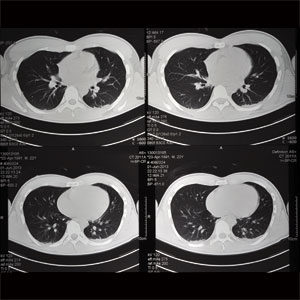Also known as a “CAT scan,” CT combines multiple x-ray images to produce a two-dimensional cross-section view with as much as 100 times more clarity than conventional x-ray.
CT imaging is used to clearly show soft tissue, like the brain, as well as dense tissue, like bone. The information gathered during a CT scan is processed by a computer and interpreted by a radiologist to diagnose, or rule out, disease.
Some CT scans require the use of a contrast medium. Given intravenously, the contrast agent highlights certain body parts to enable the radiologist to better see any abnormalities. CT scans of the abdomen and pelvis often require the patient to drink a barium-based liquid to outline the intestines for better viewing.

FAQS
While the unit is scanning the images, the CT gantry rotates in a circle to allow the x-ray tube to image from all angles. There is whirring and clicking in the CT unit while the tube is rotating for the pictures. The table will slowly slide through the ring to allow the machine to cover the necessary segment of the body. If iodinated IV contrast is used, this may cause a warm flushing feeling through the body and occasionally a metallic taste in the mouth, both of which are experienced only momentarily.
The CT scan itself usually takes 10 to 15 minutes. If you receive IV contrast, it may take slightly longer.
New CT scanning machines are designed to expose to radiation only the small part of your body that is being examined. The amount of radiation you receive is comparable to the same amount you get for plain x-rays of the abdomen or spine, depending on what areas are to be imaged. One of our goals is to perform each CT scan with as little radiation as possible while still obtaining the images needed to make a diagnosis.
If so, we do not recommend this test since there is exposure to radiation. If you are not sure, but think you may be pregnant, be sure to inform the technologist of this possibility before proceeding.
As noted above, your examination may or may not require any pre-procedure preparation.
If you have a known allergy to iodine or iodinated IV contrast (dye), please call the facility where your examination is scheduled, and ask to speak with one of the radiology nurses at least one day before your CT scan. For CT studies, in which you will receive either IV or oral contrast, please do not eat or drink anything except for the oral liquid contrast for 3 hours prior to the study.
If your CT study requires iodinated intravenous (IV) contrast (dye), you should speak with a radiology nurse the day before the study. Usually the study can be safely done with contrast even if you have an iodine-allergy history. Generally, we recommend treating you the night before and the morning of your study with several medications designed to decrease your chance of an allergic reaction. These medicines often include common histamine-blockers like Benadryl and Tagamet, and potent anti-inflammatory steroid medications. While allergic reactions to IV contrast can occur, trained physicians and nurses with necessary medications and equipment are always available to treat any reaction.
Our radiologists look at all of you CT images and compare the study with any previous exams you may have had. Our typed report is available to your doctor usually within one day.
If so, we recommend that your doctor obtain a blood test to show the status of your kidney function before you have the CT exam if it is anticipated that you will require iodinated IV contrast.
If so, we recommend that your doctor obtain a blood test to show the status of your kidney function before you have the CT exam. If you take Glucophage or Glucovance for Type II diabetes, and we administer iodinated IV contrast for the exam, we will ask you to withhold your medication for 48 hours after the exam. You may resume your medication after your doctor checks a blood test to show that your kidneys function has not changed.
